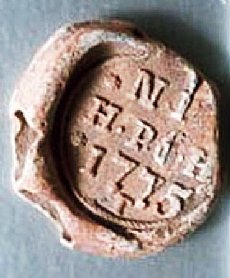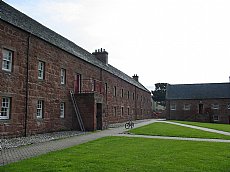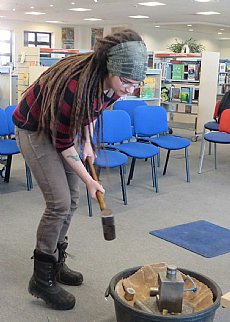Russian Lead Cloth Seal from Cromarty
02 November 2020
- News Type:
- Find of the Month
 Over 100 lead seals have been found in fields around Cromarty on the Black Isle. The seals were fixed to bales of flax and then hemp in the late 1700s and first half of the 1800s, affirming the quality of the product. Vast quantities were shipped to the UK from Russia, including to Cromarty, where spinners wove the flax into linen cloth, and the hemp into bags.
Over 100 lead seals have been found in fields around Cromarty on the Black Isle. The seals were fixed to bales of flax and then hemp in the late 1700s and first half of the 1800s, affirming the quality of the product. Vast quantities were shipped to the UK from Russia, including to Cromarty, where spinners wove the flax into linen cloth, and the hemp into bags.
Once removed from the bales, the seals were discarded, and made their way to the fields along with other midden material. The process of creating the seals was investigated as part of ARCH’s Experimental Archaeology project (http://www.archhighland.org.uk/experimental-archaeology.asp, accessed October 2020).
 A large building was built in Cromarty in 1772 –the Manufactory – where this activity took place, and which still survives in part, now converted to housing. It later was used for ropemaking, the long ranges ideal for this activity.
A large building was built in Cromarty in 1772 –the Manufactory – where this activity took place, and which still survives in part, now converted to housing. It later was used for ropemaking, the long ranges ideal for this activity.
The finished products were then shipped around the world, especially the West Indies. This international industry was an integral part of the local economy for decades, employing hundreds of people.
The development of textile production at Cromarty owes its growth to two entrepreneurs: the merchant William Forstyth (1719-1800) and local laird George Ross (1708/9 – 1786), building on initiatives of the Board of Trustees for Improving Fisheries and Manufactures in the 1720s and the British Linen Company after 1747. Forsyth relied on a local workforce, primarily female, many not local to Cromarty, but Gaelic-speaking Highlanders, which led to the erection of the Gaelic chapel. Centralising many of the procedures in the Manufactory led to quicker production (Alston 2006, 155ff).
Although both flax and hemp were grown in Scotland, there was not enough for the needs of an enterprise such as that in Cromarty, and as a result much was imported from the Baltic. The set up shows globalisation in action at this early date – hemp from Russia, made into bags which were then exported to London and then destined for the West Indies. The scale of the trade was huge: output from the Manufactory was valued around 1808 at £25,000 (Alston 2006, 162-165). Russian seals have been found in other Highland locations, many as a result of metal detecting, although this evidence remains to be brought together.
 Further Information:
Further Information:
Alston, David 2006 My little town of Cromarty. The history of a northern Scottish town, Birlinn: Edinburgh.
Cromarty Courthouse Museum holds a good collection of seals, while the Peacehaven website www.peacehavens.co.uk lists examples from the Highlands and further afield.
See also the Experimental Archaeology blog and videos relating to making lead seals.
Find of the Month Archive
- 25/07/2022 Steatite Vessels
- 10/04/2021 Cruisie lamp in Dunrobin Castle Museum
- 02/03/2021 Medieval Sword Pommel from Sleat, Skye
- 01/02/2021 Hilton of Cadboll Pictish Cross Slab
- 04/01/2021 Gunflint from Stoneyfield, Inverness
- 02/12/2020 Bobbin from Contin Bobbin Mill
- 02/11/2020 Russian Lead Cloth Seal from Cromarty
- 01/10/2020 The Poolewe Hoard
- 04/09/2020 Storr Rock Viking Silver Hoard
- 07/08/2020 Mesolithic bloodstone artefacts from Camas Daraich, Skye
